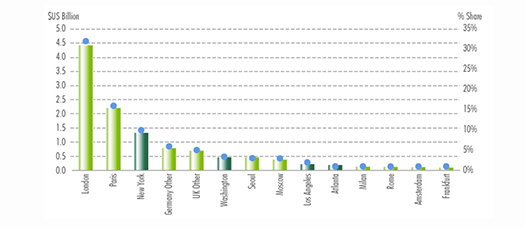- Middle Eastern Capital Increasingly Targeting U.S. Markets
- Private Investors Emerge as Major New Source of Outbound Capital
Los Angeles, 2015-8-6— /EPR Retail News/ — An average of US$15.0 billion per year will flow out of the Middle East into direct real estate globally in the near-term, with investors from the region increasingly targeting U.S markets, according to the latest research from global property advisor CBRE Group, Inc.
The Middle East continues to be one of the most important sources of cross-regional capital into the global real estate market, with US$14.0 billion invested outside of the home region in 2014—the third largest source of capital globally. Qatar, driven by its sovereign wealth funds (SWFs), was by far the largest source of outbound capital with US$4.9 billion invested. Saudi Arabia has emerged as a significant new source of capital globally, investing US$2.3 billion in 2014, up from almost no reported investment in 2013.
The Middle Eastern investor base has expanded, fueled by weakening oil prices; this has led to a major shift in global investment strategies towards greater geographic and sector diversification, with activity spreading across gateway markets to second-tier locations in Europe and the Americas. A greater proportion of Middle Eastern capital is now targeting the U.S.—the US$5.0 billion invested globally in Q1 2015 was almost equally split between Europe and Americas, with New York, Washington, D.C., Los Angeles, and Atlanta targeted. London, while retaining the top position, is no longer as dominant, with a 32 per cent share of all Middle East outbound investment in 2014, compared to 45 per cent in 2013.
Top Investment Hotspots for Middle Eastern Capital
Middle Eastern investors are becoming more active across a wider range of sectors. This is clearly evident in the U.S. where, historically, these investors have bought office buildings and trophy hotels in New York, Los Angeles and other gateway markets. Competition from Chinese investors and other global capital sources means that these investors are increasingly seeking alternatives, such as Abu Dhabi Investment Authority’s $725 million acquisition this year of a 14.2 million-sq.-ft. industrial portfolio.
“While not back to the peak levels of the pre-global financial crisis, Middle Eastern capital flows into the U.S. continue to be strong, growing and diversifying in nature. As the big sovereigns continue to seek safe havens and long-term stable growth potential, the flow of capital from the Middle East will become even stronger. We expect a greater amount of this capital to start looking beyond the gateway markets to achieve its objectives,” said Spencer Levy, Americas Head of Research, CBRE.
Private, non-institutional investors (property companies, high net worth individuals (HNWI), equity funds and any other form of private capital) have emerged as a major and increasing source of outbound capital from the Middle East. With a greater allocation to real estate and more concentration on geographical diversification away from the home region, the potential for non-institutional investors to expand their global real estate investments is of growing importance. Weaker oil prices are a strong contributing factor to this, triggering and accelerating global deployment of capital, with value-add investments in high demand. CBRE forecasts that global real estate investment by non-institutional capital from the Middle East will range from US$6.0 to $7.0 billion per annum in the near-term, if not higher, increasing from approximately US$5.0 billion per year during 2010 to 2013.
“Private capital from the Middle East is once again becoming a measurably more important investor group globally. The most immediate change will bring down the average lot size, as non-institutional investors tend to target assets at circa US$50.0 million. This extends naturally to a more diverse investment strategy—a trend already felt in the market so far in 2015 and is expected to become more pronounced in the next six to 18 months. In particular, we expect the Americas region to see more capital flows from the Middle East, with Europe less dominant than it has been over the last five years,” said Chris Ludeman, Global President, CBRE Capital Markets.
In addition to private capital, SWFs from the Middle East are also expected to remain important market-makers, albeit not as strong in their acquisition strategies as they would have been if oil prices had not fallen. It is very unlikely that regional governments will make radical decisions to affect the existing capital allocations, with only new allocations likely to be affected. CBRE expects US$7.0 to $9.0 billion per annum of Middle Eastern SWF investment to flow into direct global real estate in the near- to mid-term, compared to what would have otherwise been in the range of US$9.0 to $11.0 billion per annum had oil prices remained at levels above $100 per barrel.
About CBRE Group, Inc.
CBRE Group, Inc. (NYSE:CBG), a Fortune 500 and S&P 500 company headquartered in Los Angeles, is the world’s largest commercial real estate services and investment firm (in terms of 2014 revenue). The Company has more than 52,000 employees (excluding affiliates), and serves real estate owners, investors and occupiers through more than 370 offices (excluding affiliates) worldwide. CBRE offers strategic advice and execution for property sales and leasing; corporate services; property, facilities and project management; mortgage banking; appraisal and valuation; development services; investment management; and research and consulting. Please visit our website at www.cbre.com.
For CBRE Capital Markets news follow us on:
Twitter: @CBREcapitalmkts
LinkedIn: CBRE Global Capital Markets
For Further Information:
Aaron Richardson
T +44 20 7182 3329
email

